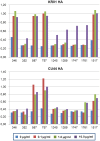Insight into highly conserved H1 subtype-specific epitopes in influenza virus hemagglutinin
- PMID: 24587046
- PMCID: PMC3935945
- DOI: 10.1371/journal.pone.0089803
Insight into highly conserved H1 subtype-specific epitopes in influenza virus hemagglutinin
Abstract
Influenza viruses continuously undergo antigenic changes with gradual accumulation of mutations in hemagglutinin (HA) that is a major determinant in subtype specificity. The identification of conserved epitopes within specific HA subtypes gives an important clue for developing new vaccines and diagnostics. We produced and characterized nine monoclonal antibodies that showed significant neutralizing activities against H1 subtype influenza viruses, and determined the complex structure of HA derived from a 2009 pandemic virus A/Korea/01/2009 (KR01) and the Fab fragment from H1-specific monoclonal antibody GC0587. The overall structure of the complex was essentially identical to the previously determined KR01 HA-Fab0757 complex structure. Both Fab0587 and Fab0757 recognize readily accessible head regions of HA, revealing broadly shared and conserved antigenic determinants among H1 subtypes. The β-strands constituted by Ser110-Glu115 and Lys169-Lys170 form H1 epitopes with distinct conformations from those of H1 and H3 HA sites. In particular, Glu112, Glu115, Lys169, and Lys171 that are highly conserved among H1 subtype HAs have close contacts with HCDR3 and LCDR3. The differences between Fab0587 and Fab0757 complexes reside mainly in HCDR3 and LCDR3, providing distinct antigenic determinants specific for 1918 pdm influenza strain. Our results demonstrate a potential key neutralizing epitope important for H1 subtype specificity in influenza virus.
Conflict of interest statement
Figures




References
-
- Dushoff J, Plotkin JB, Viboud C, Earn DJ, Simonsen L (2006) Mortality due to influenza in the United States–an annualized regression approach using multiple-cause mortality data. Am J Epidemiol 163: 181–187. - PubMed
-
- Johnson NP, Mueller J (2002) Updating the accounts: global mortality of the 1918–1920 “Spanish” influenza pandemic. Bull Hist Med 76: 105–115. - PubMed
-
- WHO.
-
- Cox NJ, Subbarao K (2000) Global epidemiology of influenza: past and present. Annu Rev Med 51: 407–421. - PubMed
Publication types
MeSH terms
Substances
Associated data
- Actions
LinkOut - more resources
Full Text Sources
Other Literature Sources

